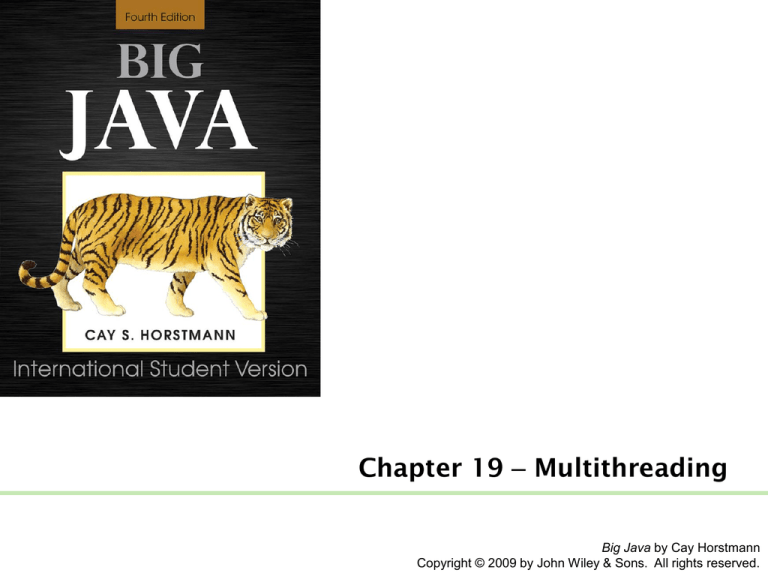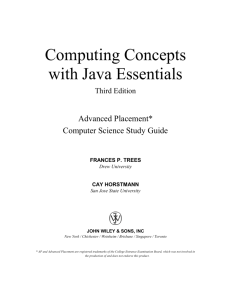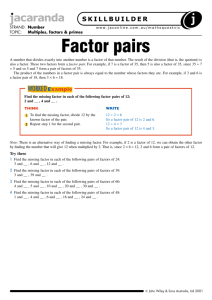
Chapter 19 – Multithreading
Big Java by Cay Horstmann
Copyright © 2009 by John Wiley & Sons. All rights reserved.
Chapter Goals
• To understand how multiple threads can execute in parallel
• To learn how to implement threads
• To understand race conditions and deadlocks
• To be able to avoid corruption of shared objects by using locks
and conditions
• To be able to use threads for programming animations
Big Java by Cay Horstmann
Copyright © 2009 by John Wiley & Sons. All rights reserved.
Threads
• Thread: a program unit that is executed independently of other
parts of the program
• The Java Virtual Machine executes each thread in the program
for a short amount of time
• This gives the impression of parallel execution
Big Java by Cay Horstmann
Copyright © 2009 by John Wiley & Sons. All rights reserved.
Running a Thread
• Implement a class that implements the Runnable interface:
public interface Runnable
{
void run();
}
• Place the code for your task into the run method of your class:
public class MyRunnable implements Runnable
{
public void run()
{
Task statements
...
}
}
Big Java by Cay Horstmann
Copyright © 2009 by John Wiley & Sons. All rights reserved.
Running a Thread
• Create an object of your subclass:
Runnable r = new MyRunnable();
• Construct a Thread object from the runnable object:
Thread t = new Thread(r);
• Call the start method to start the thread:
t.start();
Big Java by Cay Horstmann
Copyright © 2009 by John Wiley & Sons. All rights reserved.
Example
A program to print a time stamp and “Hello World” once a second
for ten seconds:
Mon
Mon
Mon
Mon
Mon
Mon
Mon
Mon
Mon
Mon
Dec
Dec
Dec
Dec
Dec
Dec
Dec
Dec
Dec
Dec
28
28
28
28
28
28
28
28
28
28
23:12:03
23:12:04
23:12:05
23:12:06
23:12:07
23:12:08
23:12:09
23:12:10
23:12:11
23:12:12
PST
PST
PST
PST
PST
PST
PST
PST
PST
PST
2009
2009
2009
2009
2009
2009
2009
2009
2009
2009
Hello,
Hello,
Hello,
Hello,
Hello,
Hello,
Hello,
Hello,
Hello,
Hello,
World!
World!
World!
World!
World!
World!
World!
World!
World!
World!
Big Java by Cay Horstmann
Copyright © 2009 by John Wiley & Sons. All rights reserved.
GreetingRunnable Outline
public class GreetingRunnable implements Runnable
{
private String greeting;
public GreetingRunnable(String aGreeting)
{
greeting = aGreeting;
}
public void run()
{
Task statements
...
}
}
Big Java by Cay Horstmann
Copyright © 2009 by John Wiley & Sons. All rights reserved.
Thread Action for GreetingRunnable
• Print a time stamp
• Print the greeting
• Wait a second
Big Java by Cay Horstmann
Copyright © 2009 by John Wiley & Sons. All rights reserved.
GreetingRunnable
• We can get the date and time by constructing a Date object:
Date now = new Date();
• To wait a second, use the sleep method of the Thread class:
sleep(milliseconds)
• A sleeping thread can generate an InterruptedException
• Catch the exception
• Terminate the thread
Big Java by Cay Horstmann
Copyright © 2009 by John Wiley & Sons. All rights reserved.
Running Threads
• sleep puts current thread to sleep for given number of
milliseconds:
Thread.sleep(milliseconds)
• When a thread is interrupted, most common response is to
terminate run
Big Java by Cay Horstmann
Copyright © 2009 by John Wiley & Sons. All rights reserved.
Generic run method
public void run()
{
try
{
Task statements
}
catch (InterruptedException exception)
{
}
Clean up, if necessary
}
Big Java by Cay Horstmann
Copyright © 2009 by John Wiley & Sons. All rights reserved.
ch19/greeting/GreetingRunnable.java
1
2
3
4
5
6
7
8
9
10
11
12
13
14
15
16
17
18
19
20
21
import java.util.Date;
/**
A runnable that repeatedly prints a greeting.
*/
public class GreetingRunnable implements Runnable
{
private static final int REPETITIONS = 10;
private static final int DELAY = 1000;
private String greeting;
/**
Constructs the runnable object.
@param aGreeting the greeting to display
*/
public GreetingRunnable(String aGreeting)
{
greeting = aGreeting;
}
Continued
Big Java by Cay Horstmann
Copyright © 2009 by John Wiley & Sons. All rights reserved.
ch19/greeting/GreetingRunnable.java (cont.)
22
23
24
25
26
27
28
29
30
31
32
33
34
35
36
37
public void run()
{
try
{
for (int i = 1; i <= REPETITIONS; i++)
{
Date now = new Date();
System.out.println(now + " " + greeting);
Thread.sleep(DELAY);
}
}
catch (InterruptedException exception)
{
}
}
}
Big Java by Cay Horstmann
Copyright © 2009 by John Wiley & Sons. All rights reserved.
To Start the Thread
• Construct an object of your runnable class:
Runnable t = new GreetingRunnable("Hello World");
• Then construct a thread and call the start method:
Thread t = new Thread(r);
t.start();
Big Java by Cay Horstmann
Copyright © 2009 by John Wiley & Sons. All rights reserved.
ch19/greeting/GreetingThreadRunner.java
1
2
3
4
5
6
7
8
9
10
11
12
13
14
15
/**
This program runs two greeting threads in parallel.
*/
public class GreetingThreadRunner
{
public static void main(String[] args)
{
GreetingRunnable r1 = new GreetingRunnable("Hello, World!");
GreetingRunnable r2 = new GreetingRunnable("Goodbye, World!");
Thread t1 = new Thread(r1);
Thread t2 = new Thread(r2);
t1.start();
t2.start();
}
}
Continued
Big Java by Cay Horstmann
Copyright © 2009 by John Wiley & Sons. All rights reserved.
ch19/greeting/GreetingThreadRunner.java (cont.)
Program Run:
Mon
Mon
Mon
Mon
Mon
Mon
Mon
Mon
Mon
Mon
Mon
Mon
Mon
Mon
Mon
Mon
Mon
Mon
Mon
Mon
Dec
Dec
Dec
Dec
Dec
Dec
Dec
Dec
Dec
Dec
Dec
Dec
Dec
Dec
Dec
Dec
Dec
Dec
Dec
Dec
28
28
28
28
28
28
28
28
28
28
28
28
28
28
28
28
28
28
28
28
12:04:46
12:04:46
12:04:47
12:04:47
12:04:48
12:04:48
12:04:49
12:04:49
12:04:50
12:04:50
12:04:51
12:04:51
12:04:52
12:04:52
12:04:53
12:04:53
12:04:54
12:04:54
12:04:55
12:04:55
PST
PST
PST
PST
PST
PST
PST
PST
PST
PST
PST
PST
PST
PST
PST
PST
PST
PST
PST
PST
2009
2009
2009
2009
2009
2009
2009
2009
2009
2009
2009
2009
2009
2009
2009
2009
2009
2009
2009
2009
Hello, World!
Goodbye, World!
Hello, World!
Goodbye, World!
Hello, World!
Goodbye, World!
Hello, World!
Goodbye, World!
Hello, World!
Goodbye, World!
Hello, World!
Goodbye, World!
Goodbye, World!
Hello, World!
Hello, World!
Goodbye, World!
Hello, World!
Goodbye, World!
Hello, World!
Goodbye, World!
Big Java by Cay Horstmann
Copyright © 2009 by John Wiley & Sons. All rights reserved.
Thread Scheduler
• Thread scheduler: runs each thread for a short amount of time
(a time slice)
• Then the scheduler activates another thread
• There will always be slight variations in running times especially when calling operating system services (e.g. input
and output)
• There is no guarantee about the order in which threads are
executed
Big Java by Cay Horstmann
Copyright © 2009 by John Wiley & Sons. All rights reserved.
Self Check 19.1
What happens if you change the call to the sleep method in the
run method to Thread.sleep(1)?
Answer: The messages are printed about one millisecond
apart.
Big Java by Cay Horstmann
Copyright © 2009 by John Wiley & Sons. All rights reserved.
Self Check 19.2
What would be the result of the program if the main method
called
r1.run();
r2.run();
instead of starting threads?
Answer: The first call to run would print ten “Hello”
messages, and then the second call to run would print ten
“Goodbye” messages
Big Java by Cay Horstmann
Copyright © 2009 by John Wiley & Sons. All rights reserved.
Terminating Threads
• A thread terminates when its run method terminates
• Do not terminate a thread using the deprecated stop method
• Instead, notify a thread that it should terminate:
t.interrupt();
• interrupt does not cause the thread to terminate – it sets a
boolean variable in the thread data structure
Big Java by Cay Horstmann
Copyright © 2009 by John Wiley & Sons. All rights reserved.
Terminating Threads
• The run method should check occasionally whether it has been
interrupted
• Use the interrupted method
• An interrupted thread should release resources, clean up, and exit:
public void run()
{
for (int i = 1;
i <= REPETITIONS && !Thread.interrupted();
i++)
{
Do work
}
Clean up
}
Big Java by Cay Horstmann
Copyright © 2009 by John Wiley & Sons. All rights reserved.
Terminating Threads
• The sleep method throws an InterruptedException when
a sleeping thread is interrupted
• Catch the exception
• Terminate the thread :
public void run()
{
try
{
for (int i = 1; i <= REPETITIONS; i++)
{
Do work
Sleep
}
}
catch (InterruptedException exception)
{
Clean up
}
Big Java by Cay Horstmann
Copyright © 2009 by John Wiley & Sons. All rights reserved.
}
Terminating Threads
• Java does not force a thread to terminate when it is interrupted
• It is entirely up to the thread what it does when it is interrupted
• Interrupting is a general mechanism for getting the thread’s
attention
Big Java by Cay Horstmann
Copyright © 2009 by John Wiley & Sons. All rights reserved.
Self Check 19.3
Suppose a web browser uses multiple threads to load the images
on a web page. Why should these threads be terminated when
the user hits the “Back” button?
Answer: If the user hits the “Back” button, the current web
page is no longer displayed, and it makes no sense to expend
network resources for fetching additional image data.
Big Java by Cay Horstmann
Copyright © 2009 by John Wiley & Sons. All rights reserved.
Self Check 19.4
Consider the following Runnable:
public class MyRunnable implements Runnable
{
public void run()
{
try
{
System.out.println(1);
Thread.sleep(1000);
System.out.println(2);
}
catch (InterruptedException exception)
{
System.out.println(3);
}
System.out.println(4);
}
}
BigContinued
Java by Cay Horstmann
Copyright © 2009 by John Wiley & Sons. All rights reserved.
Self Check 19.4 (cont.)
Suppose a thread with this Runnable is started and immediately
interrupted.
Thread t = new Thread(new MyRunnable());
t.start();
t.interrupt();
What output is produced?
Answer: The run method prints the values 1, 3, and 4. The call
to interrupt merely sets the interruption flag, but the sleep
method immediately throws an InterruptedException.
Big Java by Cay Horstmann
Copyright © 2009 by John Wiley & Sons. All rights reserved.
Race Conditions
• When threads share a common object, they can conflict with
each other
• Sample program: multiple threads manipulate a bank account
Here is the run method of DepositRunnable:
public void run()
{
try
{
for (int i = 1; i <= count; i++)
{
account.deposit(amount);
Thread.sleep(DELAY);
}
}
catch (InterruptedException exception)
{
}
}
Big Java by Cay Horstmann
Copyright © 2009 by John Wiley & Sons. All rights reserved.
Race Conditions
• The WithdrawRunnable class is similar
Big Java by Cay Horstmann
Copyright © 2009 by John Wiley & Sons. All rights reserved.
Sample Application
• Create a BankAccount object
• Create two sets of threads:
• Each thread in the first set repeatedly deposits $100
• Each thread in the second set repeatedly withdraws $100
• deposit and withdraw have been modified to print
messages:
public void deposit(double amount)
{
System.out.print("Depositing " + amount);
double newBalance = balance + amount;
System.out.println(", new balance is "
+ newBalance);
balance = newBalance;
}
Big Java by Cay Horstmann
Copyright © 2009 by John Wiley & Sons. All rights reserved.
Sample Application
• The result should be zero, but sometimes it is not
• Normally, the program output looks somewhat like this:
Depositing 100.0, new balance is 100.0
Withdrawing 100.0, new balance is 0.0
Depositing 100.0, new balance is 100.0
Depositing 100.0, new balance is 200.0
Withdrawing 100.0, new balance is 100.0
...
Withdrawing 100.0, new balance is 0.0
• But sometimes you may notice messed-up output, like this:
Depositing 100.0Withdrawing 100.0, new balance is
100.0, new balance is -100.0
Big Java by Cay Horstmann
Copyright © 2009 by John Wiley & Sons. All rights reserved.
Scenario to Explain Non-zero Result: Race Condition
1. A deposit thread executes the lines:
System.out.print("Depositing " + amount);
double newBalance = balance + amount;
The balance variable is still 0, and the newBalance local
variable is 100
2. The deposit thread reaches the end of its time slice and a
withdraw thread gains control
3. The withdraw thread calls the withdraw method which
withdraws $100 from the balance variable; it is now -100
4. The withdraw thread goes to sleep
Continued
Big Java by Cay Horstmann
Copyright © 2009 by John Wiley & Sons. All rights reserved.
Scenario to Explain Non-zero Result: Race Condition
5. The deposit thread regains control and picks up where it left off;
it executes:
System.out.println(", new balance is " + newBalance);
balance = newBalance;
The balance is now 100 instead of 0 because the deposit
method used the OLD balance
Big Java by Cay Horstmann
Copyright © 2009 by John Wiley & Sons. All rights reserved.
Corrupting the Contents of the balance Variable
Big Java by Cay Horstmann
Copyright © 2009 by John Wiley & Sons. All rights reserved.
Race Condition
• Occurs if the effect of multiple threads on shared data depends
on the order in which they are scheduled
• It is possible for a thread to reach the end of its time slice in the
middle of a statement
• It may evaluate the right-hand side of an equation but not be
able to store the result until its next turn:
public void deposit(double amount)
{
balance = balance + amount;
System.out.print("Depositing " + amount
+ ", new balance is " + balance);
}
• Race condition can still occur:
balance = the right-hand-side value
Big Java by Cay Horstmann
Copyright © 2009 by John Wiley & Sons. All rights reserved.
ch19/unsynch/BankAccountThreadRunner.java
1
2
3
4
5
6
7
8
9
10
11
12
13
14
15
16
17
18
19
20
21
22
23
/**
This program runs threads that deposit and withdraw
money from the same bank account.
*/
public class BankAccountThreadRunner
{
public static void main(String[] args)
{
BankAccount account = new BankAccount();
final double AMOUNT = 100;
final int REPETITIONS = 100;
final int THREADS = 100;
for (int i = 1; i <= THREADS; i++)
{
DepositRunnable d = new DepositRunnable(
account, AMOUNT, REPETITIONS);
WithdrawRunnable w = new WithdrawRunnable(
account, AMOUNT, REPETITIONS);
Thread dt = new Thread(d);
Thread wt = new Thread(w);
Continued
Big Java by Cay Horstmann
Copyright © 2009 by John Wiley & Sons. All rights reserved.
ch19/unsynch/BankAccountThreadRunner.java (cont.)
24
25
26
27
28
dt.start();
wt.start();
}
}
}
Big Java by Cay Horstmann
Copyright © 2009 by John Wiley & Sons. All rights reserved.
ch19/unsynch/DepositRunnable.java
1
2
3
4
5
6
7
8
9
10
11
12
13
14
15
16
17
18
19
20
21
22
23
24
/**
A deposit runnable makes periodic deposits to a bank account.
*/
public class DepositRunnable implements Runnable
{
private static final int DELAY = 1;
private BankAccount account;
private double amount;
private int count;
/**
Constructs a deposit runnable.
@param anAccount the account into which to deposit money
@param anAmount the amount to deposit in each repetition
@param aCount the number of repetitions
*/
public DepositRunnable(BankAccount anAccount, double anAmount,
int aCount)
{
account = anAccount;
amount = anAmount;
Continued
count = aCount;
}
Big Java by Cay Horstmann
Copyright © 2009 by John Wiley & Sons. All rights reserved.
ch19/unsynch/DepositRunnable.java (cont.)
25
26
27
28
29
30
31
32
33
34
35
36
37
public void run()
{
try
{
for (int i = 1; i <= count; i++)
{
account.deposit(amount);
Thread.sleep(DELAY);
}
}
catch (InterruptedException exception) {}
}
}
Big Java by Cay Horstmann
Copyright © 2009 by John Wiley & Sons. All rights reserved.
ch19/unsynch/WithdrawRunnable.java
1
2
3
4
5
6
7
8
9
10
11
12
13
14
15
16
17
18
19
20
21
22
23
24
/**
A withdraw runnable makes periodic withdrawals from a bank account.
*/
public class WithdrawRunnable implements Runnable
{
private static final int DELAY = 1;
private BankAccount account;
private double amount;
private int count;
/**
Constructs a withdraw runnable.
@param anAccount the account from which to withdraw money
@param anAmount the amount to withdraw in each repetition
@param aCount the number of repetitions
*/
public WithdrawRunnable(BankAccount anAccount, double anAmount,
int aCount)
{
account = anAccount;
amount = anAmount;
Continued
count = aCount;
}
Big Java by Cay Horstmann
Copyright © 2009 by John Wiley & Sons. All rights reserved.
ch19/unsynch/WithdrawRunnable.java (cont.)
25
26
27
28
29
30
31
32
33
34
35
36
37
public void run()
{
try
{
for (int i = 1; i <= count; i++)
{
account.withdraw(amount);
Thread.sleep(DELAY);
}
}
catch (InterruptedException exception) {}
}
}
Big Java by Cay Horstmann
Copyright © 2009 by John Wiley & Sons. All rights reserved.
ch19/unsynch/BankAccount.java
1
2
3
4
5
6
7
8
9
10
11
12
13
14
15
16
/**
A bank account has a balance that can be changed by
deposits and withdrawals.
*/
public class BankAccount
{
private double balance;
/**
Constructs a bank account with a zero balance.
*/
public BankAccount()
{
balance = 0;
}
Continued
Big Java by Cay Horstmann
Copyright © 2009 by John Wiley & Sons. All rights reserved.
ch19/unsynch/BankAccount.java (cont.)
17
18
19
20
21
22
23
24
25
26
27
28
/**
Deposits money into the bank account.
@param amount the amount to deposit
*/
public void deposit(double amount)
{
System.out.print("Depositing " + amount);
double newBalance = balance + amount;
System.out.println(", new balance is " + newBalance);
balance = newBalance;
}
Continued
Big Java by Cay Horstmann
Copyright © 2009 by John Wiley & Sons. All rights reserved.
ch19/unsynch/BankAccount.java (cont.)
29
30
31
32
33
34
35
36
37
38
39
40
41
42
43
44
45
46
47
48
49
/**
Withdraws money from the bank account.
@param amount the amount to withdraw
*/
public void withdraw(double amount)
{
System.out.print("Withdrawing " + amount);
double newBalance = balance - amount;
System.out.println(", new balance is " + newBalance);
balance = newBalance;
}
/**
Gets the current balance of the bank account.
@return the current balance
*/
public double getBalance()
{
return balance;
}
}
Big Java by Cay Horstmann
Copyright © 2009 by John Wiley & Sons. All rights reserved.
ch19/unsynch/BankAccount.java (cont.)
Program Run:
Depositing 100.0, new balance is 100.0
Withdrawing 100.0, new balance is 0.0
Depositing 100.0, new balance is 100.0
Withdrawing 100.0, new balance is 0.0
...
Withdrawing 100.0, new balance is 400.0
Depositing 100.0, new balance is 500.0
Withdrawing 100.0, new balance is 400.0
Withdrawing 100.0, new balance is 300.0
Big Java by Cay Horstmann
Copyright © 2009 by John Wiley & Sons. All rights reserved.
Self Check 19.5
Give a scenario in which a race condition causes the bank
balance to be -100 after one iteration of a deposit thread and a
withdraw thread.
Answer: There are many possible scenarios. Here is one:
• The first thread loses control after the first print statement.
• The second thread loses control just before the assignment balance
= newBalance.
• The first thread completes the deposit method.
• The second thread completes the withdraw method.
Big Java by Cay Horstmann
Copyright © 2009 by John Wiley & Sons. All rights reserved.
Self Check 19.6
Suppose two threads simultaneously insert objects into a linked
list. Using the implementation in Chapter 15, explain how the list
can be damaged in the process.
Answer: One thread calls addFirst and is preempted just
before executing the assignment first = newLink. Then
the next thread calls addFirst, using the old value of first.
Then the first thread completes the process, setting first to
its new link. As a result, the links are not in sequence.
Big Java by Cay Horstmann
Copyright © 2009 by John Wiley & Sons. All rights reserved.
Synchronizing Object Access
• To solve problems such as the one just seen, use a lock object
• Lock object: used to control threads that manipulate shared
resources
• In Java: Lock interface and several classes that implement it
• ReentrantLock: most commonly used lock class
• Locks are a feature of Java version 5.0
• Earlier versions of Java have a lower-level facility for thread
synchronization
Big Java by Cay Horstmann
Copyright © 2009 by John Wiley & Sons. All rights reserved.
Synchronizing Object Access
• Typically, a lock object is added to a class whose methods
access shared resources, like this:
public class BankAccount
{
private Lock balanceChangeLock;
public BankAccount()
{
balanceChangeLock = new ReentrantLock();
...
}
...
}
Big Java by Cay Horstmann
Copyright © 2009 by John Wiley & Sons. All rights reserved.
Synchronizing Object Access
• Code that manipulates shared resource is surrounded by calls to
lock and unlock:
balanceChangeLock.lock();
Manipulate the shared resource
balanceChangeLock.unlock();
• If code between calls to lock and unlock throws an exception,
call to unlock never happens
Big Java by Cay Horstmann
Copyright © 2009 by John Wiley & Sons. All rights reserved.
Synchronizing Object Access
• To overcome this problem, place call to unlock into a finally
clause:
public void deposit(double amount)
{
balanceChangeLock.lock();
try
{
System.out.print("Depositing " + amount);
double newBalance = balance + amount;
System.out.println(", new balance is " +
newBalance);
balance = newBalance;
}
finally
{
balanceChangeLock.unlock();
}
}
Big Java by Cay Horstmann
Copyright © 2009 by John Wiley & Sons. All rights reserved.
Synchronizing Object Access
• When a thread calls lock, it owns the lock until it calls unlock
• A thread that calls lock while another thread owns the lock is
temporarily deactivated
• Thread scheduler periodically reactivates thread so it can try to
acquire the lock
• Eventually, waiting thread can acquire the lock
Big Java by Cay Horstmann
Copyright © 2009 by John Wiley & Sons. All rights reserved.
Visualizing Object Locks
Big Java by Cay Horstmann
Copyright © 2009 by John Wiley & Sons. All rights reserved.
Self Check 19.7
If you construct two BankAccount objects, how many lock
objects are created?
Answer: Two, one for each bank account object. Each lock
protects a separate balance variable.
Big Java by Cay Horstmann
Copyright © 2009 by John Wiley & Sons. All rights reserved.
Self Check 19.8
What happens if we omit the call unlock at the end of the
deposit method?
Answer: When a thread calls deposit, it continues to own
the lock, and any other thread trying to deposit or withdraw
money in the same bank account is blocked forever.
Big Java by Cay Horstmann
Copyright © 2009 by John Wiley & Sons. All rights reserved.
Avoiding Deadlocks
• A deadlock occurs if no thread can proceed because each
thread is waiting for another to do some work first
• BankAccount example:
public void withdraw(double amount)
{
balanceChangeLock.lock();
try
{
while (balance < amount)
Wait for the balance to grow
...
}
finally
{
balanceChangeLock.unlock();
}
}
Big Java by Cay Horstmann
Copyright © 2009 by John Wiley & Sons. All rights reserved.
Avoiding Deadlocks
• How can we wait for the balance to grow?
• We can’t simply call sleep inside withdraw method;
thread will block all other threads that want to use
balanceChangeLock
• In particular, no other thread can successfully execute deposit
• Other threads will call deposit, but will be blocked until
withdraw exits
• But withdraw doesn’t exit until it has funds available
• DEADLOCK
Big Java by Cay Horstmann
Copyright © 2009 by John Wiley & Sons. All rights reserved.
Condition Objects
• To overcome problem, use a condition object
• Condition objects allow a thread to temporarily release a lock,
and to regain the lock at a later time
• Each condition object belongs to a specific lock object
Big Java by Cay Horstmann
Copyright © 2009 by John Wiley & Sons. All rights reserved.
Condition Objects (cont.)
• You obtain a condition object with newCondition method of
Lock interface:
public class BankAccount
{
public BankAccount()
{
balanceChangeLock = new ReentrantLock();
sufficientFundsCondition =
balanceChangeLock.newCondition();
...
}
...
private Lock balanceChangeLock;
private Condition sufficientFundsCondition;
}
Big Java by Cay Horstmann
Copyright © 2009 by John Wiley & Sons. All rights reserved.
Condition Objects
• It is customary to give the condition object a name that
describes condition to test
• You need to implement an appropriate test
Big Java by Cay Horstmann
Copyright © 2009 by John Wiley & Sons. All rights reserved.
Condition Objects (cont.)
• As long as test is not fulfilled, call await on the condition object:
public void withdraw(double amount)
{
balanceChangeLock.lock();
try
{
while (balance < amount)
sufficientFundsCondition.await();
...
}
finally
{
balanceChangeLock.unlock();
}
}
Big Java by Cay Horstmann
Copyright © 2009 by John Wiley & Sons. All rights reserved.
Condition Objects
• Calling await
• Makes current thread wait
• Allows another thread to acquire the lock object
• To unblock, another thread must execute signalAll on the
same condition object :
sufficientFundsCondition.signalAll();
• signalAll unblocks all threads waiting on the condition
• signal: randomly picks just one thread waiting on the object
and unblocks it
• signal can be more efficient, but you need to know that every
waiting thread can proceed
• Recommendation: always call signalAll
Big Java by Cay Horstmann
Copyright © 2009 by John Wiley & Sons. All rights reserved.
ch19/synch/BankAccountThreadRunner.java
1
2
3
4
5
6
7
8
9
10
11
12
13
14
15
16
17
18
19
20
21
22
23
/**
This program runs threads that deposit and withdraw
money from the same bank account.
*/
public class BankAccountThreadRunner
{
public static void main(String[] args)
{
BankAccount account = new BankAccount();
final double AMOUNT = 100;
final int REPETITIONS = 100;
final int THREADS = 100;
for (int i = 1; i <= THREADS; i++)
{
DepositRunnable d = new DepositRunnable(
account, AMOUNT, REPETITIONS);
WithdrawRunnable w = new WithdrawRunnable(
account, AMOUNT, REPETITIONS);
Thread dt = new Thread(d);
Thread wt = new Thread(w);
Continued
Big Java by Cay Horstmann
Copyright © 2009 by John Wiley & Sons. All rights reserved.
ch19/synch/BankAccountThreadRunner.java (cont.)
24
25
26
27
28
dt.start();
wt.start();
}
}
}
Big Java by Cay Horstmann
Copyright © 2009 by John Wiley & Sons. All rights reserved.
ch19/synch/BankAccount.java
1
2
3
4
5
6
7
8
9
10
11
12
13
14
15
16
17
18
19
20
21
22
23
24
import java.util.concurrent.locks.Condition;
import java.util.concurrent.locks.Lock;
import java.util.concurrent.locks.ReentrantLock;
/**
A bank account has a balance that can be changed by
deposits and withdrawals.
*/
public class BankAccount
{
private double balance;
private Lock balanceChangeLock;
private Condition sufficientFundsCondition;
/**
Constructs a bank account with a zero balance.
*/
public BankAccount()
{
balance = 0;
balanceChangeLock = new ReentrantLock();
sufficientFundsCondition = balanceChangeLock.newCondition();
Continued
}
Big Java by Cay Horstmann
Copyright © 2009 by John Wiley & Sons. All rights reserved.
ch19/synch/BankAccount.java (cont.)
25
26
27
28
29
30
31
32
33
34
35
36
37
38
39
40
41
42
43
44
45
/**
Deposits money into the bank account.
@param amount the amount to deposit
*/
public void deposit(double amount)
{
balanceChangeLock.lock();
try
{
System.out.print("Depositing " + amount);
double newBalance = balance + amount;
System.out.println(", new balance is " + newBalance);
balance = newBalance;
sufficientFundsCondition.signalAll();
}
finally
{
balanceChangeLock.unlock();
}
}
Continued
Big Java by Cay Horstmann
Copyright © 2009 by John Wiley & Sons. All rights reserved.
ch19/synch/BankAccount.java (cont.)
46
47
48
49
50
51
52
53
54
55
56
57
58
59
60
61
62
63
64
65
66
67
68
/**
Withdraws money from the bank account.
@param amount the amount to withdraw
*/
public void withdraw(double amount)
throws InterruptedException
{
balanceChangeLock.lock();
try
{
while (balance < amount)
sufficientFundsCondition.await();
System.out.print("Withdrawing " + amount);
double newBalance = balance - amount;
System.out.println(", new balance is " + newBalance);
balance = newBalance;
}
finally
{
balanceChangeLock.unlock();
}
}
Continued
Big Java by Cay Horstmann
Copyright © 2009 by John Wiley & Sons. All rights reserved.
ch19/synch/BankAccount.java (cont.)
69
70
71
72
73
74
75
76
77
/**
Gets the current balance of the bank account.
@return the current balance
*/
public double getBalance()
{
return balance;
}
}
Continued
Big Java by Cay Horstmann
Copyright © 2009 by John Wiley & Sons. All rights reserved.
ch19/synch/BankAccount.java (cont.)
Program Run:
Depositing 100.0, new balance is 100.0
Withdrawing 100.0, new balance is 0.0
Depositing 100.0, new balance is 100.0
Depositing 100.0, new balance is 200.0
...
Withdrawing 100.0, new balance is 100.0
Depositing 100.0, new balance is 200.0
Withdrawing 100.0, new balance is 100.0
Withdrawing 100.0, new balance is 0.0
Big Java by Cay Horstmann
Copyright © 2009 by John Wiley & Sons. All rights reserved.
Self Check 19.9
What is the essential difference between calling sleep and
await?
Answer: A sleeping thread is reactivated when the sleep delay
has passed. A waiting thread is only reactivated if another
thread has called signalAll or signal.
Big Java by Cay Horstmann
Copyright © 2009 by John Wiley & Sons. All rights reserved.
Self Check 19.10
Why is the sufficientFundsCondition object an instance
variable of the BankAccount class and not a local variable of the
withdraw and deposit methods?
Answer: The calls to await and signal/signalAll must
be made to the same object.
Big Java by Cay Horstmann
Copyright © 2009 by John Wiley & Sons. All rights reserved.
An Application of Threads: Animation
• Shows different objects moving or changing as time progresses
• Is often achieved by launching one or more threads that
compute how parts of the animation change
• Can use Swing Timer class for simple animations
• More advanced animations are best implemented with threads
• An algorithm animation helps visualize the steps in the algorithm
Big Java by Cay Horstmann
Copyright © 2009 by John Wiley & Sons. All rights reserved.
Algorithm Animation
• Runs in a separate thread that periodically updates an image of
the current state of the algorithm
• It then pauses so the user can see the change
• After a short time the algorithm thread wakes up and runs to the
next point of interest
• It updates the image again and pauses again
Big Java by Cay Horstmann
Copyright © 2009 by John Wiley & Sons. All rights reserved.
Selection Sort Algorithm Animation
• Items in the algorithm’s state
• The array of values
• The size of the already sorted area
• The currently marked element
• This state is accessed by two threads:
1. One that sorts the array, and
2. One that repaints the frame
• To visualize the algorithm
• Show the sorted part of the array in a different color
• Mark the currently visited array element in red
Big Java by Cay Horstmann
Copyright © 2009 by John Wiley & Sons. All rights reserved.
A Step in the Animation of the Selection Sort Algorithm
Big Java by Cay Horstmann
Copyright © 2009 by John Wiley & Sons. All rights reserved.
Selection Sort Algorithm Animation: Implementation
• Use a lock to synchronize access to the shared state
• Add a component instance variable to the algorithm class and
augment the constructor to set it
• That instance variable is needed for
• Repainting the component, and
• Finding out the dimensions of the component when drawing the algorithm
state
Big Java by Cay Horstmann
Copyright © 2009 by John Wiley & Sons. All rights reserved.
Selection Sort Algorithm Animation: Implementation
public class SelectionSorter
{
private JComponent component;
public SelectionSorter(int[] anArray,
Jcomponent aComponent)
{
a = anArray;
sortStateLock = new ReentrantLock();
component = aComponent;
}
...
}
Big Java by Cay Horstmann
Copyright © 2009 by John Wiley & Sons. All rights reserved.
Selection Sort Algorithm Animation: Implementation
• At each point of interest, algorithm needs to pause so user can
observe the graphical output
• We need a pause method that repaints component and sleeps
for a small delay:
public void pause(int steps)
throws InterruptedException
{
component.repaint();
Thread.sleep(steps * DELAY);
}
• Delay is proportional to the number of steps involved
• pause should be called at various places in the algorithm
Big Java by Cay Horstmann
Copyright © 2009 by John Wiley & Sons. All rights reserved.
Selection Sort Algorithm Animation: Implementation
• We add a draw method to the algorithm class
• draw draws the current state of the data structure, highlighting
items of special interest
• draw is specific to the particular algorithm
• In this case, draws the array elements as a sequence of sticks in
different colors
• The already sorted portion is blue
• The marked position is red
• The remainder is black
Big Java by Cay Horstmann
Copyright © 2009 by John Wiley & Sons. All rights reserved.
Selection Sort Algorithm Animation: draw
public void draw(Graphics2D g2)
{
sortStateLock.lock();
try
{
int deltaX = component.getWidth() / a.length;
for (int i = 0; i < a.length; i++)
{
if (i == markedPosition)
g2.setColor(Color.RED);
else if (i <= alreadySorted)
g2.setColor(Color.BLUE);
else
g2.setColor(Color.BLACK);
g2.draw(new Line2D.Double(i * deltaX, 0, i * deltaX,
a[i]));
}
Continued
}
Big Java by Cay Horstmann
Copyright © 2009 by John Wiley & Sons. All rights reserved.
Selection Sort Algorithm Animation: draw (cont.)
finally
{
sortStateLock.unlock();
}
}
Big Java by Cay Horstmann
Copyright © 2009 by John Wiley & Sons. All rights reserved.
Selection Sort Algorithm Animation: Pausing
• Update the special positions as the algorithm progresses
• Pause the animation whenever something interesting happens
• Pause should be proportional to the number of steps that are
being executed
• In this case, pause one unit for each visited array element
• Augment minimumPosition and sort accordingly
Big Java by Cay Horstmann
Copyright © 2009 by John Wiley & Sons. All rights reserved.
Selection Sort Algorithm Animation: Pausing
public int minimumPosition(int from)
throws InterruptedException
{
int minPos = from;
for (int i = from + 1; i < a.length; i++)
{
sortStateLock.lock();
try
{
if (a[i] < a[minPos]) minPos = i;
markedPosition = i;
}
finally
{
sortStateLock.unlock();
Continued
Big Java by Cay Horstmann
Copyright © 2009 by John Wiley & Sons. All rights reserved.
Selection Sort Algorithm Animation: Pausing (cont.)
}
pause(2); // two array elements were inspected
}
return minPos;
}
Big Java by Cay Horstmann
Copyright © 2009 by John Wiley & Sons. All rights reserved.
Selection Sort Algorithm Animation: paintComponent
• paintComponent calls the draw method of the algorithm
object:
public class SelectionSortComponent extends JComponent
{
private SelectionSorter sorter;
public void paintComponent(Graphics g)
{
if (sorter == null) return;
Graphics2D g2 = (Graphics2D) g;
sorter.draw(g2);
}
...
}
Big Java by Cay Horstmann
Copyright © 2009 by John Wiley & Sons. All rights reserved.
Selection Sort Algorithm Animation: startAnimation
public void startAnimation()
{
int[] values = ArrayUtil.randomIntArray(30, 300);
sorter = new SelectionSorter(values, this);
class AnimationRunnable implements Runnable
{
public void run()
{
try
{
sorter.sort();
}
catch (InterruptedException exception)
{
}
}
Continued
Big Java by Cay Horstmann
Copyright © 2009 by John Wiley & Sons. All rights reserved.
Selection Sort Algorithm Animation: startAnimation
(cont.)
}
Runnable r = new AnimationRunnable();
Thread t = new Thread(r);
t.start();
}
Big Java by Cay Horstmann
Copyright © 2009 by John Wiley & Sons. All rights reserved.
ch19/animation/SelectionSortViewer.java
1
2
3
4
5
6
7
8
9
10
11
12
13
14
15
16
17
18
19
20
21
22
23
24
import java.awt.BorderLayout;
import javax.swing.JButton;
import javax.swing.JFrame;
public class SelectionSortViewer
{
public static void main(String[] args)
{
JFrame frame = new JFrame();
final int FRAME_WIDTH = 300;
final int FRAME_HEIGHT = 400;
frame.setSize(FRAME_WIDTH, FRAME_HEIGHT);
frame.setDefaultCloseOperation(JFrame.EXIT_ON_CLOSE);
final SelectionSortComponent component
= new SelectionSortComponent();
frame.add(component, BorderLayout.CENTER);
frame.setVisible(true);
component.startAnimation();
}
}
Big Java by Cay Horstmann
Copyright © 2009 by John Wiley & Sons. All rights reserved.
ch19/animation/SelectionSortComponent.java
1
2
3
4
5
6
7
8
9
10
11
12
13
14
15
16
17
18
19
20
import java.awt.Graphics;
import java.awt.Graphics2D;
import javax.swing.JComponent;
/**
A component that displays the current state of the selection sort algorithm.
*/
public class SelectionSortComponent extends JComponent
{
private SelectionSorter sorter;
/**
Constructs the component.
*/
public SelectionSortComponent()
{
int[] values = ArrayUtil.randomIntArray(30, 300);
sorter = new SelectionSorter(values, this);
}
Continued
Big Java by Cay Horstmann
Copyright © 2009 by John Wiley & Sons. All rights reserved.
ch19/animation/SelectionSortComponent.java (cont.)
21
22
23
24
25
26
public void paintComponent(Graphics g)
{
Graphics2D g2 = (Graphics2D)g;
sorter.draw(g2);
}
Continued
Big Java by Cay Horstmann
Copyright © 2009 by John Wiley & Sons. All rights reserved.
ch19/animation/SelectionSortComponent.java (cont.)
27
28
29
30
31
32
33
34
35
36
37
38
39
40
41
42
43
44
45
46
47
48
49
50
/**
Starts a new animation thread.
*/
public void startAnimation()
{
class AnimationRunnable implements Runnable
{
public void run()
{
try
{
sorter.sort();
}
catch (InterruptedException exception)
{
}
}
}
Runnable r = new AnimationRunnable();
Thread t = new Thread(r);
t.start();
}
}
Big Java by Cay Horstmann
Copyright © 2009 by John Wiley & Sons. All rights reserved.
ch19/animation/SelectionSorter.java
1
2
3
4
5
6
7
8
9
10
11
12
13
14
15
16
17
18
19
20
21
22
23
24
import
import
import
import
import
import
java.awt.Color;
java.awt.Graphics2D;
java.awt.geom.Line2D;
java.util.concurrent.locks.Lock;
java.util.concurrent.locks.ReentrantLock;
javax.swing.JComponent;
/**
This class sorts an array, using the selection sort algorithm.
*/
public class SelectionSorter
{
private static final int DELAY = 100;
private int[] a;
private Lock sortStateLock;
// The component is repainted when the animation is paused
private JComponent component;
// These instance variables are needed for drawing
private int markedPosition = -1;
private int alreadySorted = -1;
Continued
Big Java by Cay Horstmann
Copyright © 2009 by John Wiley & Sons. All rights reserved.
ch19/animation/SelectionSorter.java (cont.)
25
26
27
28
29
30
31
32
33
34
35
36
37
/**
Constructs a selection sorter.
@param anArray the array to sort
@param aComponent the component to be repainted when the animation
pauses
*/
public SelectionSorter(int[] anArray, JComponent aComponent)
{
a = anArray;
sortStateLock = new ReentrantLock();
component = aComponent;
}
Continued
Big Java by Cay Horstmann
Copyright © 2009 by John Wiley & Sons. All rights reserved.
ch19/animation/SelectionSorter.java (cont.)
38
39
40
41
42
43
44
45
46
47
48
49
50
51
52
53
54
55
56
57
58
59
60
61
/**
Sorts the array managed by this selection sorter.
*/
public void sort()
throws InterruptedException
{
for (int i = 0; i < a.length - 1; i++)
{
int minPos = minimumPosition(i);
sortStateLock.lock();
try
{
swap(minPos, i);
// For animation
alreadySorted = i;
}
finally
{
sortStateLock.unlock();
}
pause(2);
}
}
Continued
Big Java by Cay Horstmann
Copyright © 2009 by John Wiley & Sons. All rights reserved.
ch19/animation/SelectionSorter.java (cont.)
62
63
64
65
66
67
68
69
70
71
72
73
74
75
76
77
78
79
80
81
82
83
84
/**
Finds the smallest element in a tail range of the array
@param from the first position in a to compare
@return the position of the smallest element in the
range a[from]...a[a.length - 1]
*/
private int minimumPosition(int from)
throws InterruptedException
{
int minPos = from;
for (int i = from + 1; i < a.length; i++)
{
sortStateLock.lock();
try
{
if (a[i] < a[minPos]) minPos = i;
// For animation
markedPosition = i;
}
finally
{
sortStateLock.unlock();
}
Continued
Big Java by Cay Horstmann
Copyright © 2009 by John Wiley & Sons. All rights reserved.
ch19/animation/SelectionSorter.java (cont.)
85
86
87
88
89
90
91
92
93
94
95
96
97
98
99
100
101
pause(2);
}
return minPos;
}
/**
Swaps two entries of the array.
@param i the first position to swap
@param j the second position to swap
*/
private void swap(int i, int j)
{
int temp = a[i];
a[i] = a[j];
a[j] = temp;
}
Continued
Big Java by Cay Horstmann
Copyright © 2009 by John Wiley & Sons. All rights reserved.
ch19/animation/SelectionSorter.java (cont.)
102
103
104
105
106
107
108
109
110
111
112
113
114
115
116
117
118
119
120
121
122
123
/**
Draws the current state of the sorting algorithm.
@param g2 the graphics context
*/
public void draw(Graphics2D g2)
{
sortStateLock.lock();
try
{
int deltaX = component.getWidth() / a.length;
for (int i = 0; i < a.length; i++)
{
if (i == markedPosition)
g2.setColor(Color.RED);
else if (i <= alreadySorted)
g2.setColor(Color.BLUE);
else
g2.setColor(Color.BLACK);
g2.draw(new Line2D.Double(i * deltaX, 0,
i * deltaX, a[i]));
}
}
Continued
Big Java by Cay Horstmann
Copyright © 2009 by John Wiley & Sons. All rights reserved.
ch19/animation/SelectionSorter.java (cont.)
124
125
126
127
128
129
130
131
132
133
134
135
136
137
138
139
140
finally
{
sortStateLock.unlock();
}
}
/**
Pauses the animation.
@param steps the number of steps to pause
*/
public void pause(int steps)
throws InterruptedException
{
component.repaint();
Thread.sleep(steps * DELAY);
}
}
Big Java by Cay Horstmann
Copyright © 2009 by John Wiley & Sons. All rights reserved.
Self Check 19.11
Why is the draw method added to the SelectionSorter class
and not the SelectionSortComponent class?
Answer: The draw method uses the array values and the
values that keep track of the algorithm’s progress. These
values are available only in the SelectionSorter class.
Big Java by Cay Horstmann
Copyright © 2009 by John Wiley & Sons. All rights reserved.
Self Check 19.12
Would the animation still work if the startAnimation method
simply called sorter.sort() instead of spawning a thread that
calls that method?
Answer: Yes, provided you only show a single frame. If you
modify the SelectionSortViewer program to show two
frames, you want the sorters to run in parallel.
Big Java by Cay Horstmann
Copyright © 2009 by John Wiley & Sons. All rights reserved.
Embedded Systems
Big Java by Cay Horstmann
Copyright © 2009 by John Wiley & Sons. All rights reserved.






